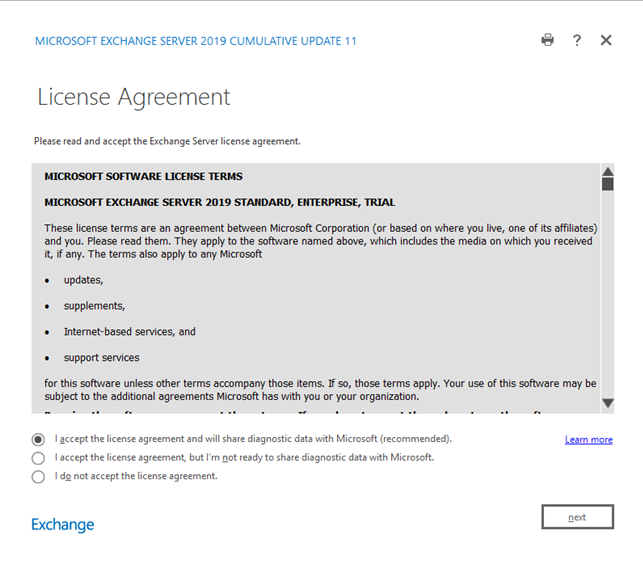Diagnostic Data collected for Exchange Server
Microsoft collects diagnostic data to keep Exchange Server secure and up to date, find and fix problems, and identify and mitigate threats. When the September 2021 (or later) Cumulative Update (CU) is installed on a Mailbox server, Exchange Server 2016 or Exchange Server 2019 has the ability to send diagnostic data from each Exchange server to the Office Config Service (OCS) in the Microsoft cloud. There's a change to the License Agreement acceptance process to allow you to choose whether to share diagnostic data with Microsoft.
Change in License Term acceptance process
When using the graphical user interface (GUI) version of Exchange Setup, a new License Agreement screen will appear, as shown below.
Instead of two options, there are now three options.

Choose one of the following options:
| Selection | Description |
|---|---|
| I accept the license agreement and will share diagnostic data with Microsoft | This is the default option that accepts the license agreement and enables sending data to Microsoft. |
| I accept the license agreement, but I'm not ready to share diagnostic data with Microsoft | This option accepts the license agreement but disables sending data to Microsoft. |
| I do not accept the license agreement | If you don't accept the EULA, you can't install the CU. |
Unattended Setup of Exchange Server
The acceptance options are also available via an unattended command-line setup using the new Setup switches:
| Selection | Description |
|---|---|
| /IAcceptExchangeServerLicenseTerms_DiagnosticDataON | Use this switch to accept the license terms and send optional data to Microsoft when the EM service requests mitigations. |
| /IAcceptExchangeServerLicenseTerms_DiagnosticDataOFF | Use this new setup switch to accept the license terms and disable sending optional data to Microsoft. |
Important
/IAcceptExchangeServerLicenseTerms has been removed from Exchange server command-line Setup and replaced with the two new Setup switches shown above.
Diagnostic Data collected
When diagnostic data collection is enabled, your Exchange server sends the following information hourly to the Office Config Service:
| Data | Description |
|---|---|
| ExchangeVersion | The server version (CU and SU build information) |
| ServiceState | Information about the Emergency Mitigation Service state (enabled or disabled) |
| ImmutableDeviceId | Unique identifier for the server |
| ImmutableOrgId | Unique identifier for the Exchange organization |
| ConfigurationsApplied | A list of all mitigations that were applied |
| ConfigurationsBlocked | A list of all mitigations that were blocked |
| MiscConfigurations | Information about the following Exchange Server component state:
|
Starting with the Exchange Server 2019 CU15 (2025H1), Exchange Server collects the following additional telemetry data:
| Data | Description |
|---|---|
| PrimaryKey | A unique identifier for the server that acts as primary key: {OrganizationId}.{DeviceId} |
| OrganizationId | Unique identifier for the Exchange organization |
| DeviceId | Unique MachineId identifier for the server |
| RemoteMailboxCount | Total count of mailboxes where RecipientTypeDetails is RemoteUserMailbox |
| ServerVersion | The build number of the Exchange Server build running on the server |
| ServerRole | The Exchange Server role running on the server |
| IsPPE | Indicator whether this is a pre-production Exchange Server installation or not (default is false) |
| MailBoxDataValue | Total count of mailboxes within the organization and on a per Exchange server base |
| AuthServerDataList | Information about the Auth Server configured in the organization:
|
| AcceptedDomainsList | Information about the Accepted Domains configured in the organization:
|
| AmsiDataValue | Information about the AMSI configuration:
|
| BinaryFormatterDataValue | Information about the Binary Formatter configuration:
|
| FlightingDataValue | Information about the flights configured via Feature Flighting:
|
How to configure the Diagnostic Data setting after installation is complete
After the Setup has completed, you can enable and disable sending the diagnostic data to the OCS on any Exchange server using the Set-ExchangeServer cmdlet.
To disable sending optional data to Microsoft:
Set-ExchangeServer -Identity <ServerName> -DataCollectionEnabled:$false
To enable sending optional data to Microsoft:
Set-ExchangeServer -Identity <ServerName> -DataCollectionEnabled:$true